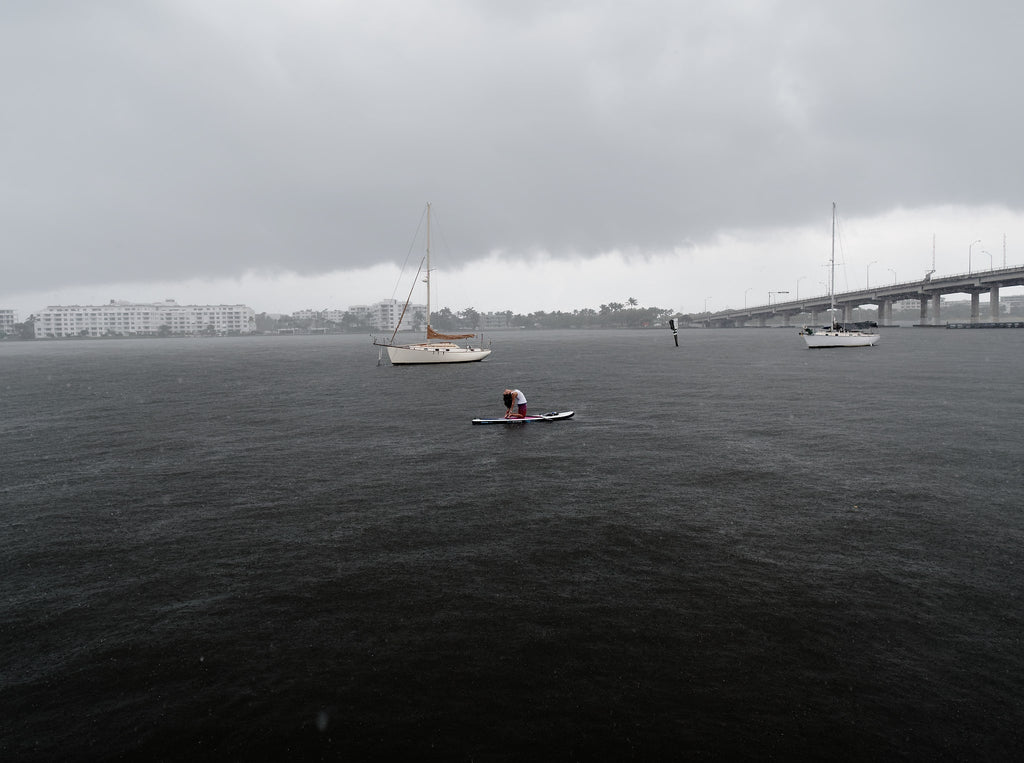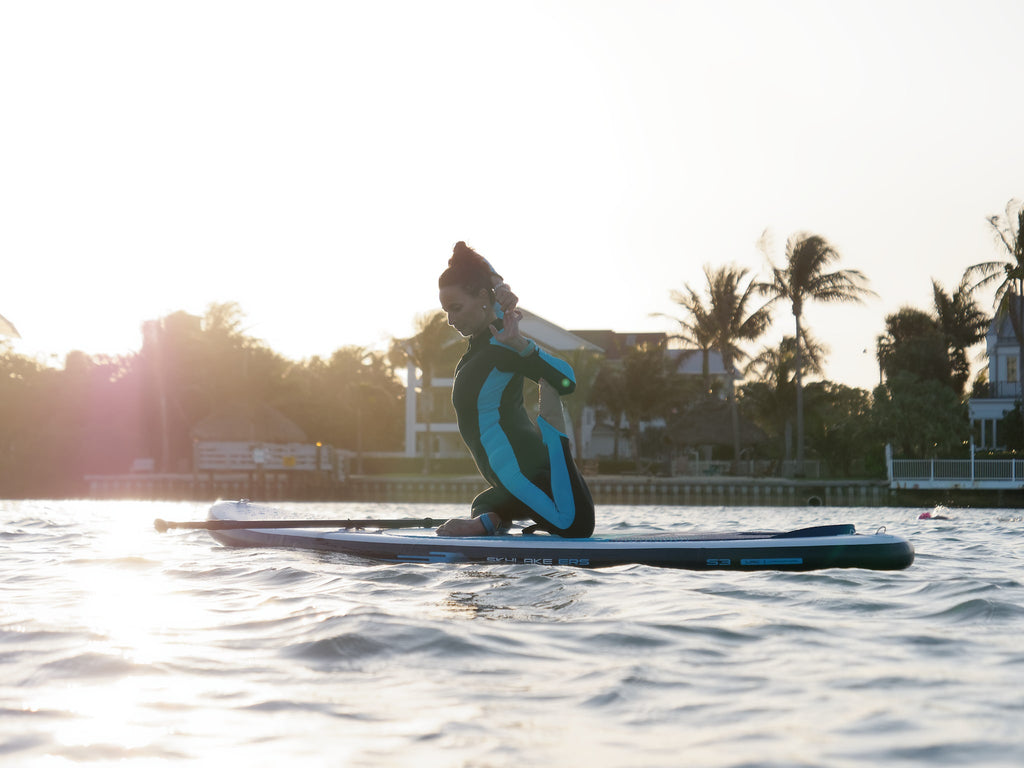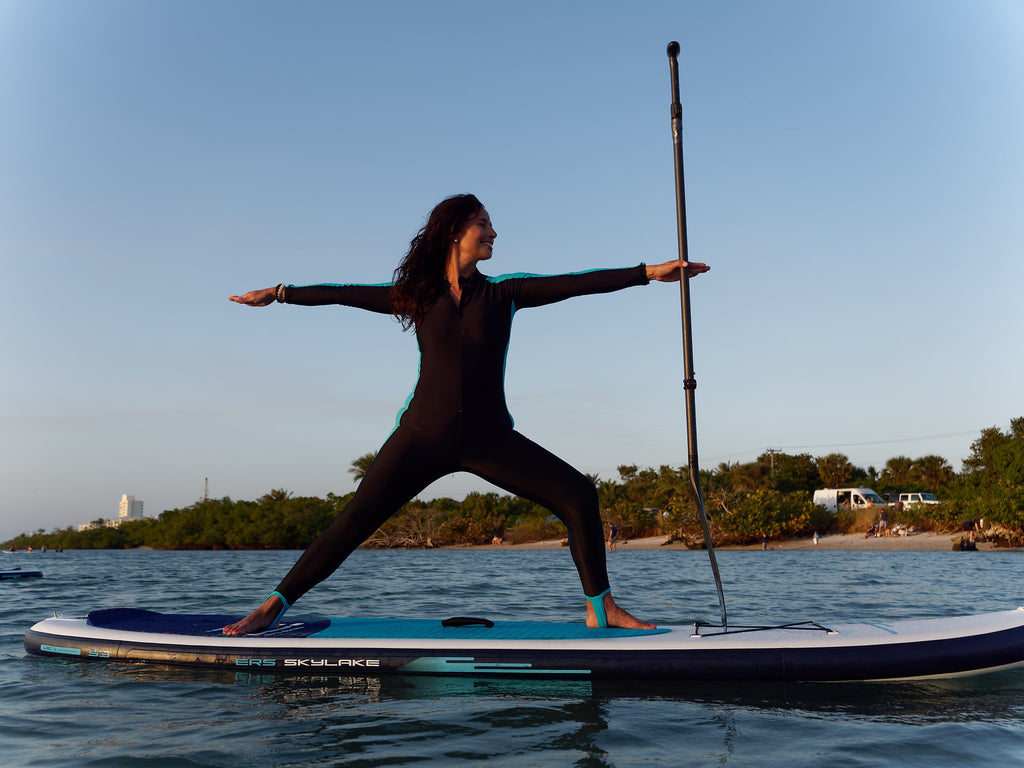
How To Choose A Paddle Board for SUP Yoga
After having had the unique and fulfilling experience of practicing Yoga on a SUP board you may have decided that it’s time to go out and buy a SUP Yoga board of your own.
After all, SUP Yoga is a great way to enjoy being out on the water. Being outdoors and in particular on the water adds another sensory dimension to the practice of Yoga. From a physical standpoint, being on a board adds an element of instability that challenges you and engages additional muscles.
If you have decided that SUP Yoga will be something you do regularly, you might be considering purchasing a board specifically designed for it. A SUP Yoga board will have some features designed for Yoga, but do you actually need such a specialized board?
Boards sold specifically for SUP Yoga are typically a version of an existing all around stability board, but with some modifications to the deck pad and accessory attachments that make the board more yoga specific. When you carefully compare features, you may find that you’re better off with an all-around inflatable SUP that has the ideal setup for Yoga but performs well for other paddling activities too.

Stand up paddle boarding adds new levels and challenges to mat based yoga. The outdoor elements and floating on water bring a unique energy to every session.
What Board Proportions Are Ideal For A Yoga Board?
While you could perform SUP Yoga on virtually any board, beginners will want to start on the most stable possible platform. This will give you the best opportunities as you progress to add more challenging poses to your flow sequences and give you confidence in your equipment each session.
Most people know that the stability of a SUP board is dictated by its width. What is less well known is how the thickness of the board affects its stability.
A board that is 36 inches wide might seem like an obvious choice for stability. But if the board is 6 inches thick, all bets are off. A board that is 34 inches wide and only 5 inches thick will actually be more stable because it will ride lower on the water than the 6-inch board. If you attempt yoga on a 6-inch board and then try the same positions on a 5-inch board, you’ll notice the difference immediately.

Want to discuss SUP Yoga and getting the best SUP yoga paddle board? - work with us to get expert advice on the pros and cons of different paddle board features and how they really relate to yoga centric paddling and on-water use.
Keep in mind that a 5-inch board is quite a bit easier to climb back onto than a 6-inch board, in the case you do find yourself in the water and is going to be a lot more fun to casually paddle when you are not doing yoga.
Board length has only a minor effect on SUP Yoga stability, especially when looking at suitable all-around alternatives, so opt for a convenient length in the 10-11 foot range. A shorter board under 10ft will be difficult to stretch out on during some poses, so in this instance a board larger than that is better for most people.

Inversions and more difficult poses are a lot of fun on a stand up paddle board. The water provides a soft landing if it doesn't go to plan! Featured Product - ERS Skylake 10-9 S3 Aqua
Deck Pad
Boards marketed for SUP Yoga will often have a deck pad that runs the full length of the board. While this may fit preconceived notions of how a sup yoga board should look, bear in mind that you will generally never find yourself at the extreme reaches of the board while doing yoga - You would tip over before getting that close to either end of the board! A deck pad that covers up to a half to three-fourths of the board surface will suffice. The extra space beyond the deck pad is where the bungee system should be located so that you have a place for your water bottle, dry bag, and other belongings.
You’ll want the deck pad to be similar to your mat and to have a fairly flat texture that won’t leave marks on your skin. The use of a towel will be a personal preference and will depend on the intensity of your session, and weather conditions but most people won't use or need one provided the deck pad has good grip.
Also, look for a center handle that flattens so you can lie on top of it without discomfort. A flat strap handle with a removable hand grip cover is ideal because it will protect your hands while carrying the board and you can take it off when you want to do yoga.
Some yoga specific boards have handles at the edges of the deck pad to keep the center area of the pad completely smooth, but boards with this off-center handle arrangement can be awkward to carry, as they have a tendency to drag on the ground due to the handle position, require you to carry it over your head, or use strap systems that are a little ungainly, given the general size of an inflatable SUP.

A stable all-around SUP board can work well for SUP Yoga and provide an amazing board for more varied SUP pursuits.
Fin Set Up
Fins do not significantly effect the performance of the board on the water while doing SUP yoga. However, there are some pros and cons to different fins systems that will affect the use of the board in general.
A permanent 3-fin setup works well for Yoga because you don’t need to stress over lost or damaged fins and it makes it easier to get into the water if you’re starting in a shallow area.
A configurable fin system in which all of the fins are removable adds some cost but allows you to remove the fins for practicing your SUP yoga, on land. You can also use a board with a permanent 3-fin setup on land, but you’ll need to prop it up a few inches to keep the fins off the ground. A foam roller can be used for this and we’d like to think most yoga enthusiasts would have one handy.
It is also worth evaluating the fin system for all-around use if you expect to use the board for purposes other than yoga, in which case a configurable fin system gives you more flexibility to adapt the board to other uses and environments. For most SUP setups there is no right answer simply choose either a permanent fin setup or look for one that is fully configurable.
Many boards also offer a mixed fin setup that comprises a combination of permanent fins (usually on the sides) and a removable center fin. Even though we sell several models with mixed fin systems, our general thoughts are that these systems are not the best choice for any type of paddling and don’t really provide the advantages of a dedicated permanent fin set up, or a fully configurable setup.
In real world use a mixed fin setup comes across as confused as to what the board design is trying to achieve, and once a paddler grows and get more experienced they realize how limiting such a setup will be.

Featured Product - ERS Skylake 10-7 S3 Aqua
Inflatable vs. Hard SUP Board for Yoga
Inflatables are the obvious choice over hard boards for SUP yoga. An inflatable SUP has a softer surface which is much easier on the body than a hard epoxy surface. In addition, inflatables are more stable than hard boards of comparable dimensions because the thickness of an inflatable paddle board is consistent across the width of the board, while hard boards are tapered at the edges, making them more tippy.
An added advantage to buying an inflatable paddle board for yoga is that you can take it with you when you travel to exotic locations where practicing aquatic yoga can be the experience of a lifetime!

A clutter free board with a larger larger deck pad will give you the ability to really stretch out on any pose with confidence. Featured Product - ERS Deck 10-9 S3
Focus on Features And Ignore The Marketing Hype
Think about what really differentiates any SUP Yoga board you are considering from a similarly shaped all around board. Will you use the part of the deck pad that extends all the way to the nose of the board, or will you be better off having a bungee system for holding your gear? Do you want the handles positioned off-center or using a complex strap system, even though it will be more difficult carrying the board to the water? That is up to each paddler to decide but our point being a dedicated yoga board isn’t a must, even for serious yoga paddlers.

The right Yoga SUP board for you will depend on many factors and it will ultimately come down too how much time you will split between SUP Yoga and other types of paddling. Featured Product - ERS Deck 10-7 S3 Orange
If you decide to go with an all-around inflatable SUP, choose one with a wide deck, moderate thickness, a mid deck pad area that is clutter free of mounts and d-rings that covers a wide section of the board, and a removable handle grip. This will give you all the advantages you need for yoga and as a bonus, you’ll also have an ideal board for any type of paddling you want to do.
See our best inflatable paddle boards for yoga here.

Want Expert Advice on Choosing an Inflatable SUP Board?
Check out our 2025 Inflatable Paddle Board Buying Guide - or - The Best Inflatable Paddle Board - Reality vs the Internet.
Want To Buy an Inflatable SUP Board?
Explore our range of SUP boards for sale by activity / use in Inflatable SUP Type or focus on Inflatable SUP Brands to find the right board for you.
Want Answers to Anything Stand Up Paddle Boarding and Inflatable SUP?
The Pumped Up SUP SUP Paddle Blog is the best resource on the internet for up to date information to help with your next inflatable SUP purchase!




